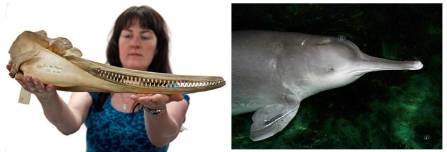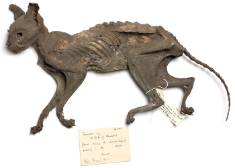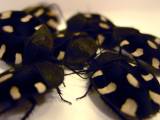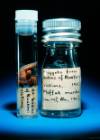It's only 3 days to go till our After Hours: Science Uncovered big night this Friday, 24 September, and the last operational plans are in frantic motion.
Yesterday was the dress rehearsal for scientists to bring out their star specimens and run through setting up the event's science stations in the Central Hall. The 9 Face to Face science stations are mostly located in the Museum's Central Hall bays. Each represents one of the Museum's main science departments and will showcase specimens from our collections and their research.
Left: This complete skull of the female Yangtze River dolphin (also known as Baiji), was collected from Tung Ting Lake in 1922. It is on show at Science Uncovered and measures 54cm long and has 36 pairs of teeth in its upper and lower jaws.
Right: A live Chinese River dolphin rescued from the Yangtze River in 1980. She died in 2002. AFP/Getty Images
At the science stations you'll find some truly precious and extraordinary specimens to explore and discuss face to face with our experts. Many have never been on public display before. It's vital that they are handled securely and the timings of the rota of exhibits runs to schedule. During the evening from 16.00 onwards, different scientists with their different chosen specimens will alternate on shift
Of special interest will be the complete skull of the now-extinct Yangtze River dolphin (above) on display at the Zoology Station, courtesy of our renowned mammals curator Richard Sabin. This rare female skull came into the Museum's collection in 1922. There are only a few specimens of this extinct species in museums worldwide, so preserving it is crucial. This is what Richard has to say about the Yangtze River dolphin skull:
'The reason I am showcasing this specimen is to highlight how the nature of museum collections and specimens can change, and how they reflect what is taking place in the world. The extinction of a large marine mammal is not only a sad loss to biodiversity, it is also a shock that you cannot adequately prepare yourself for. As curator of marine mammals, I am at a loss to express how I feel about never being able to see this species in the wild. The specimen will be used to investigate the genetic make-up of the species, which will hopefully provide data that can be used to help conserve other closely-related cetacean species.'
Other Zoology Station treats include a skull of a lion kept at the Tower of London more than 500 years ago. The lions were part of the Royal Menagerie, or zoo. And Richard is also going to show some of the Museum's mummified cats (right)... I did say there would be beauties and beasts, didn't I? Our Head of zoology collections Clare Valentine will also be featuring some unusual sponges (below).
Insect lovers should head off to the Past and Present Insects Station in Fossil Way for the chance to meet live creatures like the rather pretty Therea petiveriana, Domino Cockroach (pictured left), which our entomologist Ed Baker will be bringing along. These cockroaches are often kept as pets. Ed is joined by palaeontologist David Nicholson who will also present some 100-million-year-old insect fossil specimens.
Meteorite fans should check out the Mineralogy Station in the Central Hall. We'll have a piece of the very rare Allende carbonaceous chrondrite meteorite (below) that fell as a huge fireball in Mexico in 1969. The Museum has about 5,000 meteorite samples, which hold secrets of the formation of the solar system.
We hear mutterings that Alan Hart, who is leading The Vault gallery tours, will be showing some excavated Devonshire gold at the Mineralogy Station.
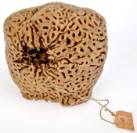 Tomatoes and poisonous algae are just a few of the botanical delights at the Botany Station, including an actual old-fashioned plant press.
Tomatoes and poisonous algae are just a few of the botanical delights at the Botany Station, including an actual old-fashioned plant press.
And there is the enigma of the giant beasts on the Dinosaurs and Whale Hall torchlit gallery tours, with the chance to learn about identifying worms at the Natural History Roadshow in Dinosaur Way.
Moving over to the Darwin Centre Forensics Station, you'll be able to glimpse the first maggots used as forensic evidence (below) to convict a criminal in a court of law. This formed part of the famous 1935 Ruxton murder case.
In short, 100s of star specimens and gallery treasures await you at Science Uncovered. This is your chance to witness them close up with the people who know them best.
After Hours: Science Uncovered is part of European Researchers' Night.
Read the latest news story about some of these rare specimens at Science Uncovered
Here are some links to related news stories about a few of these specimens that might also be of interest:
Did Egyptian mummification lead to the domestic cat? - news story
The Tower of London lion origins revealed - news story
Museum insect detectives join forensic team - news story
Click on the images to enlarge them.



